Spinocerebellar Ataxia
What is spinocerebellar ataxia?
Spinocerebellar ataxia is a genetic disorder affects normal functioning of the central nervous system, mainly characterized by walking abnormality. The patient is having coordination problem with hand and legs. In the later stage it also affects speech, visual power and other sensory and reflex actions.

Image 1: Spinocerebellar ataxia
Types
The types of spinocerebellar ataxia (SCA) depend on genetic mutation. The number of types exceeding day by day with discovering the involved genetic sequences, yet now almost 29 types of SCA discovered. These vast varieties are denoted with a numbering system such as SCA 1, SCA 2 and so on. The number is not denoted the severity of the symptoms, but the sequence of discovery of involved genetic code like SCA1 is first identified SCA. The involved genetic sequence of SCA1 was discovered in 1993. The sequence not follows the proper numbering order, as SCA 9 is not available in this sequence.
SCA 1
The predominance of this type of infection is not frequent, almost 6% incidence rate are estimated. Onset of symptoms occurs after 30 years of age. The duration of survival of the diseased person is in between 10 to 28 years. Active reflex symptoms such as vigorous mouth movement or tongue obtrude from mouth are main feature of SCA 1.
SCA 2
The incidence rate is higher than the SCA1 which is almost 15%. The onset of symptoms started at the age of 20 years and extends up to 30 years. Depending on the severity of the disease, duration of life expectancy is in between 1 to 30 years. During this period, eye movement becomes slower down and some patient also has dementia in the latter stage of life.
SCA 3
Total reported cases of SCA3 is approximately 21% and also termed as Machado-Joseph disease. The prime features of this disease are atrophy and muscle weakness. The life expectancy of this type SCA is almost 10 years, but it varies from 1- 20 years, depending upon the patient condition, treatment plan and support system.
SCA 4
This type of SCA is rare and life expectancy is normal. The symptomatic characteristic is loss of sensation and the onset of symptom started in between 30 to 40 years of age.
SCA 5
In this type of SCA, the onset of symptoms is in early age, almost 20 to 30 years. But disease progression is slow. The patient can survive more than 25 years. This type of SCA is rarely reported.
SCA 6
Approximately after 40 years of age, the onset of symptom arises and slow progression of disease occurs. The life expectancy is more than 25 years. Almost 15% incidence rate is reported.
SCA 7
Only 5% case is reported and principal characteristic is visual loss. Early onset of symptom arises at approximately 20 years of age. Duration of survival varies from 1 – 45 years.
SCA 8
The incidence rate is not too high; approximately 2-5%. Patient mainly suffers from sensation loss and active reflexes. At the age of 30 years, onset of symptom arises. Life expectancy is normal.
Other types of SCA are rare and not frequently reported; much information is not available about them. SCA 13 is developed in childhood and mental retardation is one of the major problems with the child.
Symptoms of Spinocerebellar Ataxia
Usually the initial occurrence of symptoms is in adult age. Spinocerebellar ataxia gradually progressive disorder, so symptomatic development occurs throughout prolong period. Steadily worsen the condition, but some exceptions are there for specific types of SCA.

Image 2: Location and symptoms of Spinocerebellar ataxia
- Ataxia (movement coordination difficulty )
- Problematic reflex action
- Eye movement become less prominent
- Dementia (in specific type)
- Atrophy
- Fatigue muscle
- Loss of sensory stimulation
- Tremor
- Seizures (not usual in every cases)
- Mental retardation
- Loss of visual power
Treatment of Spinocerebellar Ataxia
Medical research yet now unable to discover the curative treatment for spinocerebellar ataxia, even the available treatment is not able to control the disease progression.
The symptoms overlap with each other which are associated with various types of spinocerebellar ataxia, so it is important to determine the exact type of SCA by conducting genetic testing. Sometime conduction of genetic testing fails to reveal the exact result. Other available laboratory tests are MRI and CT scan which can diagnose the rate of disease progression.
Spinocerebellar ataxia is developed and progress due to other associated medical conditions such as metabolic disorder, vitamin insufficiency, walking disorder etc. These disorders can be controlled by available medical treatments, dietary supplements, administration of vitamins and other therapies.
Application of allied medical technologies or concerned care helps to maintain their daily living activities. Supportive treatment like physiotherapy can able to fortify their bones and muscles. These remedies are helpful for the improvement of the quality of life of the patient.
With progression of the disease condition or in advance stage, the patient needs palliative care for smoothen their survival. Psychological counselling often recommended for patient or patient representative for lessening the psychological stress and boosts their inner power. The treatment plan for this disease depends upon physical and mental condition of the patient.
References
- https://www.ataxia.org/pdf/SCA-Making_an_Informed_Choice_About_Genetic_Testing.pdf
- http://www.disabled-world.com/disability/types/sca.php
- http://www.ninds.nih.gov/disorders/ataxia/ataxia.htm
- http://www.mda.org.nz/media/1268/Spinocerebellar_Ataxia.pdf
